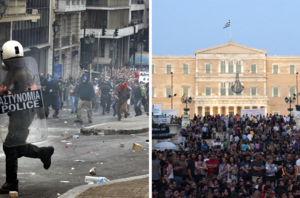Anti-austerity movement in Greece
| Anti-austerity movement in Greece | |
|---|---|
| Part of the European sovereign debt crisis and the impact of the Arab Spring | |

A police officer flees rock throwers; a crowd assembles peacefully in front of Parliament
|
|
| Date | 5 May 2010 - 4 April 2012 |
| Location | Greece |
| Causes | Unemployment, inflation, corruption, 2010–2011 Greek debt crisis, IMF presence in the country, harsh austerity measures with welfare cuts, bipartidism, particracy, democracy deficit |
| Methods | Demonstrations, strike action, sit-ins, occupations, rioting, civil disobedience, police violence |
| Casualties | |
| Death(s) | 5 May 2010: 3 20 October 2011: 1 4 April 2012 : 1 18 October 2012 : 1 |
| Injuries | 28–29 June 2011: over 270 12 February 2012: over 40 5 April 2012 : 1 (Marios Lolos) |
The anti-austerity movement in Greece involves a series of demonstrations and general strikes taking place across the country. The events, which began on 5 May 2010, were provoked by plans to cut public spending and raise taxes as austerity measures in exchange for a €110 billion bail-out, aimed at solving the Greek government-debt crisis. Three people were killed on 5 May in one of the largest demonstrations in Greece since 1973.
On 25 May 2011, anti-austerity activists organised by the Direct Democracy Now! movement, known as the Indignant Citizens Movement (Greek: Κίνημα Αγανακτισμένων Πολιτών, Kínima Aganaktisménon-Politón), started demonstrating in major cities across Greece. This second wave of demonstrations proved different from the years before in that they are not partisan and began through peaceful means. Some of the events later turned violent, particularly in the capital city of Athens. Inspired by the anti-austerity protests in Spain, these demonstrations were organised entirely using social networking sites, which earned it the nickname "May of Facebook". The demonstrations and square sit-ins were officially ended when municipal police removed demonstrators from Thessaloniki's White Tower square on 7 August 2011.
On 29 June 2011, violent clashes occurred between the riot police and activists as the Greek parliament voted to accept the EU's austerity requirements. Incidents of police brutality were reported by international media such as the BBC, The Guardian, CNN iReport and The New York Times, as well as by academic research and organisations Amnesty International. The Athens Prosecutor agreed to an investigation into accusations of excessive use of tear gas, as well as the alleged use of other expired and carcinogenic chemical substances. The investigation is currently under way.
...
Wikipedia
